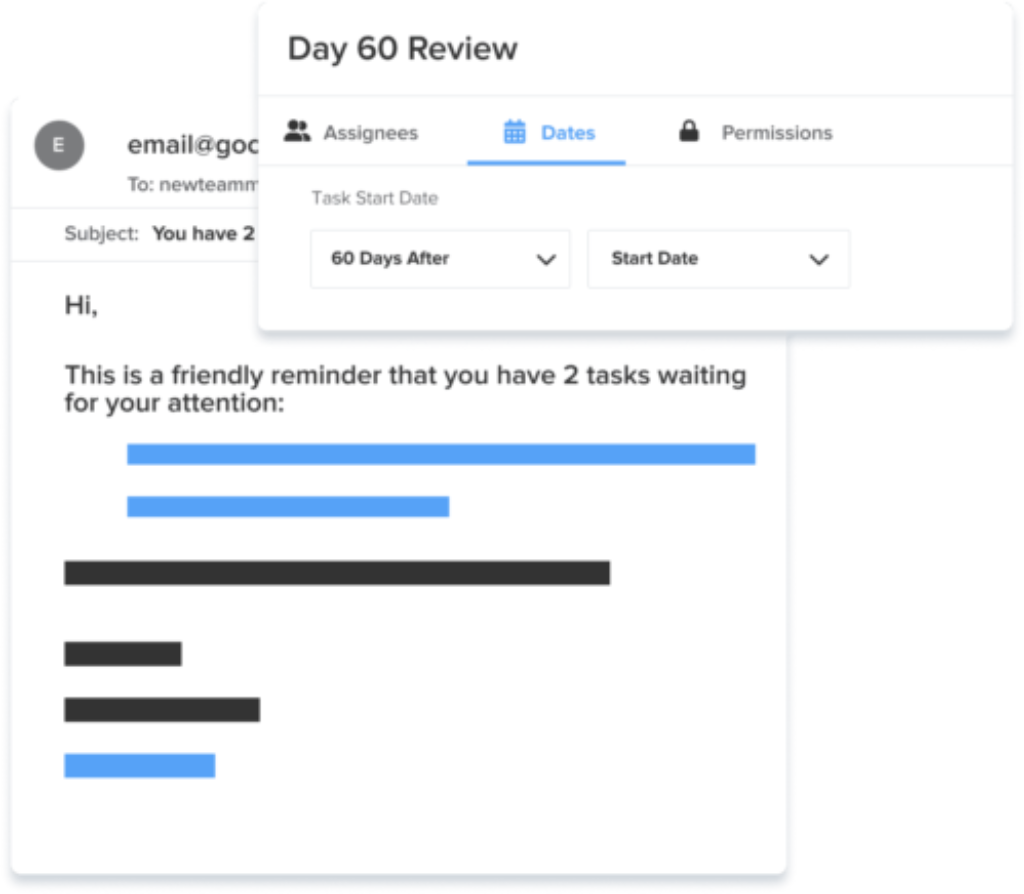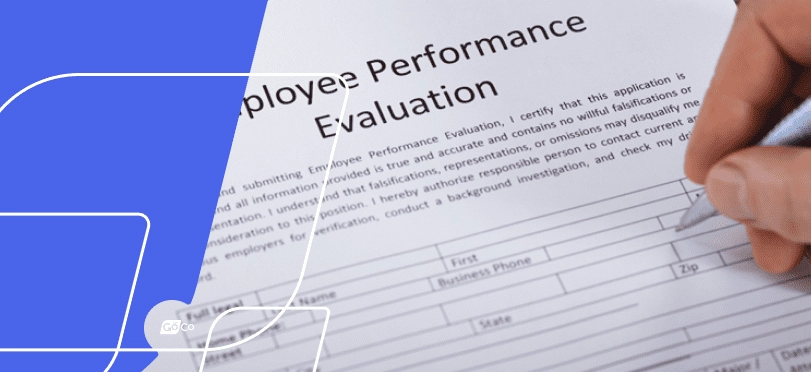5 Tips to Write Awesome Employee Performance Reviews in 2025
The performance management cycle doesn't have to be complicated. This guide helps you navigate performance reviews!
by Nick Schurk - October 9th, 2024
Writing performance reviews of your employees can take time and effort. As managers, we constantly strive to set our teams up for success, and formal reviews are a great way to keep our employees on the right track.
Download The Performance Review Ebook!
Performance appraisals are one of the essential elements of managing a team because they help us continually shape the growth and improvement of individual employees and, therefore, our entire team. Let's look at the performance management cycle and how to write a constructive performance review for you and your employee!
Table of Content
- What is Performance Management?
- Why is Performance Management Important?
- 6 Types of Performance Reviews
- 5 Ways to Write Great Employee Performance Reviews
- Questions to Ask Employees During Performance Reviews
- Next Steps After the Review
- How Often Should the Performance Management Process Occur?
- Employee Performance Review FAQs
What is Performance Management?
Performance management is an organization's process for ensuring that employees effectively and efficiently perform and coordinate their tasks to propel the company toward its goals. Performance management is quite broad and can apply to an organization, individual departments, or processes. We'll be focusing on how to conduct performance reviews for individual employees.
A performance review is a formal assessment or check-in between employees and their supervisors or managers. It helps you evaluate an employee's performance, understand the current state of the employee's strengths and weaknesses, provide feedback or highlight opportunities for improvement, and set goals for the future.
While regular check-ins are encouraged, performance reviews are typically formal, structured, written, or documented. Many organizations are also intentionally reviewing employees in more holistic and well-rounded ways – which can help act as a buffer for some of the bias that can impact a traditional 1-on-1 review process where an employee's manager is the sole decision-maker and dictates how they're performing.
Performance Reviews are a Two-Way Street
There are some best practices to keep in mind when conducting performance reviews. It's essential to frame the event as a conversation. Managers should talk through their observations and constructive feedback and elicit input from the employees themselves. Performance reviews offer an excellent opportunity to let employees ask questions. Encourage them to share their input and evaluate themselves – and then see how aligned they are with their manager's feedback.
Why is Performance Management Important?
Essentially, the core purpose of performance management is to ensure that your team’s goals are organized and aligned. Individual reviews help management get a more granular picture of each team member’s role in the company’s vision. On the other hand, these reviews help employees stay on track and make adjustments where needed within their own work! In some organizations, they also set the baseline for determining promotion and compensation changes.
6 Types of Performance Reviews
There are many different types of performance reviews, each with advantages and disadvantages. Let's discuss a few kinds you can use and how they can improve employee engagement, productivity, and retention.
Self-Assessments
Self-assessments allow the employee to reflect on their performance, strengths, and weaknesses, discuss their reflection with their manager, and hear their manager's observations.
Team Assessments
Team assessments involve evaluating the team as a whole and identifying opportunities to improve their effectiveness and how they work together.
Graphic Rating Scale
The graphic rating scale is one of the most traditional methods. It involves identifying variables such as innovation, creativity, and punctuality and rating them. Ratings can be numeric (e.g., 0-5), or they can be brief descriptors such as "Exceeds expectations "or "Needs improvement."

360-Degree Ratings
The 360-degree review gathers feedback from everyone the employee works with – including managers, other team members, and perhaps even clients or customers, depending on the role. This allows for a well-rounded and holistic understanding of their performance.
Skill Evaluations
Skill evaluation involves assessing the employee's skills, knowledge, and attitude. Both the employee and their manager assess the technical and behavioral skills or competencies that the employee demonstrates and identify the developmental level of that skill (e.g., Highly advanced vs. Not yet observed)
Goals and Results
This approach tends to be more quantitative and simply measures whether or not the employee met previously identified goals. For example, it could include assessing absentee rate, customer satisfaction, or sales conversions.
5 Ways to Write Great Employee Performance Reviews
Determining what criteria will yield you the most valuable information from a performance review can be tricky. Here are some structural elements to consider that are sure to make your review experience a positive one!
1. Provide an Overview
Review the employee's last review and refer to the assigned action items and goals. If this is their first review (e.g., a new employee or someone in a new role), refer to their job description and any metrics related to their job.
2. Restate Current Objectives
Discuss whether previous goals are being met or are in progress. If the employee is not meeting specific metrics, look at potential factors affecting their performance. For example, have projects and priorities changed since the last review?

3. Provide Actionable Feedback
The supervisor should provide specific goals and recommendations to help the employee keep moving forward. An excellent framework for your employees is SMART goals, meaning the objectives are specific, measurable, achievable, relevant, and time-bound!
4. Request Employee Feedback
As we previously stated, no review is one-sided. Ask the employee to self-evaluate their role, management, the organization, and anything else that may affect their ongoing performance.
5. Ask Employees Meaningful Questions
Asking the right questions is essential for gathering valuable information during employee performance reviews. Here are some key inquiries to make that will help you assess the employee's job performance, job satisfaction, career opportunities, and personal goals. Use these questions to guide your conversation with the employee and gain a comprehensive understanding of their performance and goals.
Questions to Evaluate Job Performance
How have things been going since our last check-in?
What specific accomplishments are you proud of during the previous six months?
What are some of the challenges you've encountered?
How have you been with time management and meeting deadlines?
How would you rate your performance on a scale of 1-10?
Where do you feel like you excel the most?
Questions to Gauge Job Satisfaction
What do you love most about your role?
What are some things that get you excited to come to work each day?
What would you want to change about your role?
Questions to Explore Career Opportunities
Where do you feel you could improve your performance?
What might you need to improve in these areas?
Are there any new skills you want to learn or projects you'd like to work on?
How can I better support you?
Is there anything the company can do to improve employee engagement and retention?
Questions to Understand Personal Goals
What goals would you like to set for yourself?
Do you see yourself in another role in this company? What can I do to help get you there?

Great! You've asked some meaningful questions and written the report! Make sure you build some sort of rubric to rank your employees' responses, especially if performance reviews tie to compensation and promotions in your company.
Next Steps After the Review
Reviews with no action plan or follow-up are pointless. It's vital to turn observations into action steps to encourage growth and improvement, which will be evaluated during the following review. Once the assessment is over, work with supervisors to create a plan based on the results. Document and share the plan with the employee to set the right expectations.
Supervisors should also plan to follow up with employees on their action items outside of a formal review process. Discuss how often you will meet with them to check in on things. Also, consider sending an email summary of the key points of your discussion. This way, the employee will have a copy of what you talked about that they can refer back to. In some cases, managers may find it appropriate to create a performance improvement plan for an employee.
How Often Should the Performance Management Process Occur?
It would be best to hold performance reviews at least once a year, but there are benefits to having them biannually. In fact, statistics show that 92% of employees want feedback more than once a year.
You might think, "If my employees dread annual performance reviews, why would we hold them more often?" You might be surprised that these conversations become more comfortable when you have them more frequently.
Plus, you can investigate the details without racking your brain to remember what the employee has been doing for the past 12 months. That way, you're incorporating performance management by not focusing just on an end goal – you're adjusting the process of getting there and coaching the employee.
Performance reviews don't have to carry the "doomsday" connotation that they commonly seem to. Suppose you and your employees think about them as a pitstop to ensure all of your organization's parts are working correctly before completing the next lap in the race. In that case, you'll get more out of the experience! The key is ensuring employees that performance management is not synonymous with punishment.
Employee Performance Review FAQs
-
Performance management is an organization's process for ensuring that employees effectively and efficiently carry out their duties to reach the company's goals. This process includes conducting formal performance reviews and assessments between employees and their managers or supervisor. These reviews evaluate performance, identify strengths and weaknesses, provide
-
Performance management is essential for ensuring that teams remain organized and that their goals align with the company's vision. Managers can better understand each team member's role through individual reviews, while employees can use these reviews to stay on track and make adjustments within their own work where needed! Some organizations also set the baseline for determining promotion and compensation changes.
-
Performance reviews can take many forms, each with its advantages. For example, self-assessments involve an employee looking back on their performance, while team assessments measure the team's overall effectiveness. Some organizations also use 360-degree ratings, skill evaluations, and other reviews.
-
An insightful employee performance review should include the following:
- An overview of the previous review and objectives.
- Actionable feedback from the supervisor.
- Employee feedback.
The supervisor should discuss whether previous goals are being met or are in progress and provide specific goals and recommendations to help the employee improve their performance. The review also needs to be a two-way street, with the employer asking specific questions related to job performance, job satisfaction, opportunities for improvement, personal goals, and any other areas which may affect ongoing performance. Lastly, employers should create a rubric to rank employees' responses to assess each individual's work adequately.
-
Performance management should occur at least once a year, but twice a year is recommended for better understanding and improved coaching. Performance reviews should be viewed as an opportunity to ensure that all parts of the organization work correctly, not as a punishment.
5 Reasons to Automate Employee Performance Reviews
Adopting HR Workflow automation software like GoCo can help you achieve:
1. Faster and Simpler Administration
Standardizing and automating performance review workflows helps simplify the administration process. The ability to customize task assignees, performance review tasks, deadlines, question form fields and more makes it much easier for HR pros and direct managers to manage their checklists and track tasks in the workflows. Reviewing permissions will be easier than ever as well!
2. Time Savings
Instead of manually completing your performance review checklist, streamlining your performance reviews helps ensure that all tasks are completed accurately and on time by the manager, employee, and other executives involved. Instead of orchestrating and manually reaching out to various departments to collect information needed for performance management, HR admin can focus on other priorities.
3. Punctual Review Completion
Manually completed checklists and performance reviews may cause confusion and mix up around due dates, as there are many moving parts. From employee self-evaluations to manager expectations, automating workflows and having a visual timeline help ensure timely review completion. You can set-up triggers and customize each element to eliminate manual follow-up on reviews.
4. Cost Savings
With automated workflows for performance reviews, HR pros and managers are able to create and assign tasks and due dates and add custom fields. The time and energy saved on streamlining these processes also allow for significant cost savings. Managers can dedicate more time to helping employees improve and providing feedback instead of getting bogged down by clunky and manual review processes.
5. Improved Employee Productivity
After automating performance review workflows, employees can easily capture and revisit their goals and manager feedback in one place. Streamlining these workflows allows for much easier collaboration between employees, admins, managers, and other team members. Goal alignment becomes tighter, and employees are able to focus on the execution of their objectives rather than the process of filling out these objectives.
Updated 10/09/2024
Recommended Posts
HR's Guide to Mid-Year Performance Reviews
Blog Articles
Search...
Product
GoCo
Resources
Articles
eBooks
Webinars
Customer Stories



